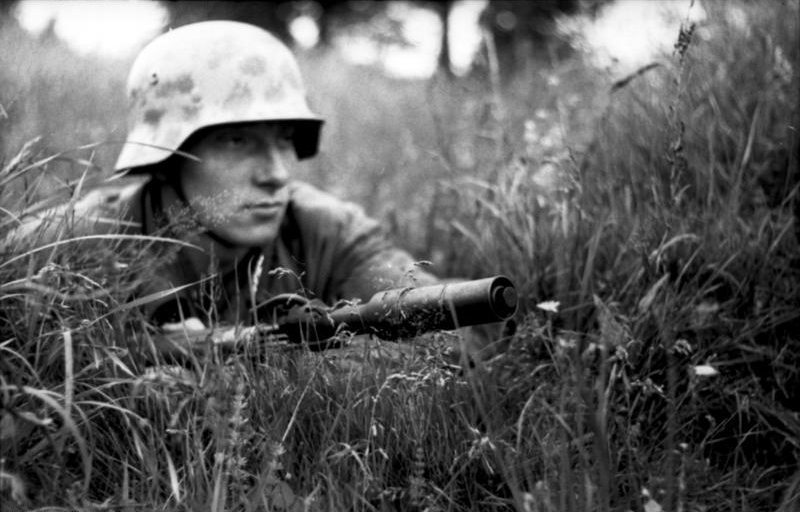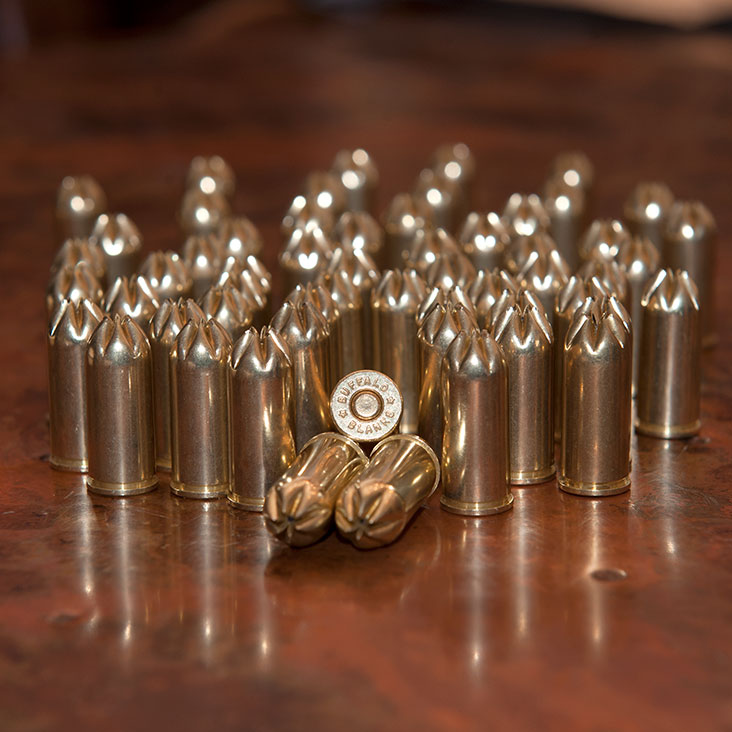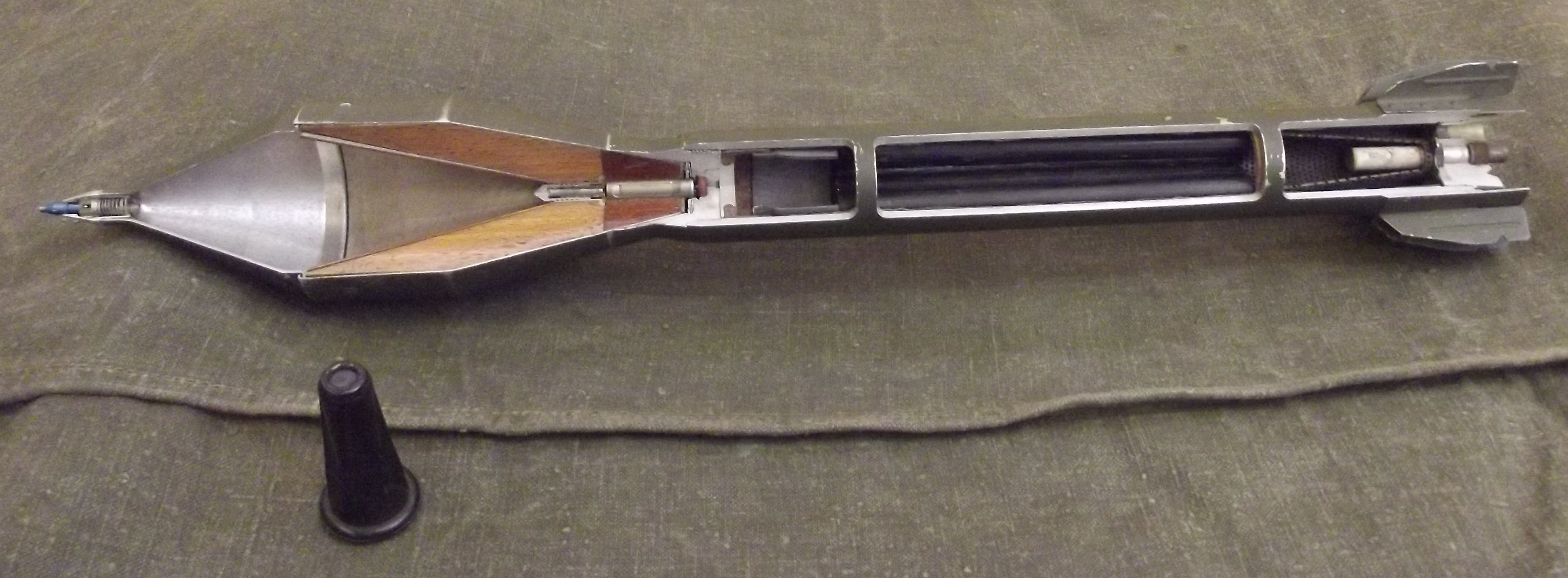|
Gross Gewehr-Panzergranate
The Große Gewehr-Panzergranate was a shaped charge rifle grenade that was developed by Germany and used by the Wehrmacht during World War II. Design The Große Gewehr-Panzergranate was launched from a Gewehrgranatengerät or Schiessbecher ("shooting cup") on a standard service rifle by a blank cartridge. The primary components were a nose cap, internal steel cone, steel upper body, aluminum lower body, rifled driving band, cast TNT filling, and a base fuze with a penthrite booster charge. The Große Gewehr-Panzergranate was an anti-armor weapon like its predecessor the Gewehr-Panzergranate but it was larger, had better penetration, and better range. Driven by the inertia upon hitting the target, the base fuze of the Große Gewehr-Panzergranate actuated a percussion cap, which fired an instantaneous detonator seated in the compressed penthrite pellet of the gaine, which in turn transmitted the detonation through an adjacent penthrite pellet (the booster) to the main TN ... [...More Info...] [...Related Items...] OR: [Wikipedia] [Google] [Baidu] |
Shaped Charge
A shaped charge is an explosive charge shaped to form an explosively formed penetrator (EFP) to focus the effect of the explosive's energy. Different types of shaped charges are used for various purposes such as cutting and forming metal, initiating nuclear weapons, penetrating armor, or perforating wells in the oil and gas industry. A typical modern shaped charge, with a metal liner on the charge cavity, can penetrate armor steel to a depth of seven or more times the diameter of the charge (charge diameters, CD), though greater depths of 10 CD and above have been achieved. Contrary to a misconception (possibly resulting from the acronym for ''high-explosive anti-tank'', HEAT) the shaped charge EFP jet does not depend in any way on heating or melting for its effectiveness; that is, the EFP jet from a shaped charge does not melt its way through armor, as its effect is purely kinetic in nature – however the process does create significant heat and often has a significant ... [...More Info...] [...Related Items...] OR: [Wikipedia] [Google] [Baidu] |
Schiessbecher
The Schiessbecher (alternatively: ''Schießbecher'') - literally "shooting cup" - was a German grenade launcher of World War II. A ''Gewehrgranatgerät'' ("rifle grenade device") based on rifle grenade launcher models designed during World War I it fitted to the end of a rifle, the grenade being propelled by a special rifle cartridge. The ''Schiessbecher'' was introduced in 1942 and intended to replace all previous rifle grenade launcher models in use by German armed forces. The ''Schiessbecher'' rifle grenade launcher could be used against infantry, fortifications and light armored vehicles up to a range of . For these differing tasks several specialized grenades with accompanying special propelling cartridges were developed for the ''Schiessbecher''. The rifle grenade propelling cartridges fired a wooden projectile through the barrel to the rifle grenade that upon impact automatically primed the rifle grenade. The ''Schiessbecher'' had a short rifled barrel with a caliber of ... [...More Info...] [...Related Items...] OR: [Wikipedia] [Google] [Baidu] |
Grenades Of Germany
A grenade is an explosive weapon typically thrown by hand (also called hand grenade), but can also refer to a Shell (projectile), shell (explosive projectile) shot from the muzzle of a rifle (as a rifle grenade) or a grenade launcher. A modern hand grenade generally consists of an explosive charge ("filler"), a detonator mechanism, an internal Firing pin, striker to trigger the detonator, and a safety lever secured by a split pin, cotter pin. The user removes the safety pin before throwing, and once the grenade leaves the hand the safety lever gets released, allowing the striker to trigger a Percussion cap, primer that ignites a fuze (sometimes called the delay element), which burns down to the detonator and explodes the main charge. Grenades work by dispersing fragments (fragmentation grenades), shockwaves (High explosive, high-explosive, Anti-tank grenade, anti-tank and stun grenades), chemical aerosols (Smoke grenade, smoke and gas grenades) or fire (incendiary grenades). Fr ... [...More Info...] [...Related Items...] OR: [Wikipedia] [Google] [Baidu] |
Superplasticity
In materials science, superplasticity is a state in which solid Crystallinity, crystalline material is deformed well beyond its usual breaking point, usually over about 600% during tensile deformation. Such a state is usually achieved at high homologous temperature. Examples of superplastic materials are some fine-grained metals and ceramics. Other non-crystalline materials (amorphous) such as silica glass ("molten glass") and polymers also deform similarly, but are not called superplastic, because they are not crystalline; rather, their deformation is often described as Newtonian fluid. Superplastically deformed material gets thinner in a very uniform manner, rather than forming a "neck" (a local narrowing) that leads to fracture. Also, the formation of microvoids, which is another cause of early fracture, is inhibited. In metals and ceramics, requirements for it being superplastic include a fine grain size (less than approximately 20 micrometres) and a fine dispersion of therma ... [...More Info...] [...Related Items...] OR: [Wikipedia] [Google] [Baidu] |
Gewehr-Panzergranate
The Gewehr-Panzergranate was a shaped charge rifle grenade that was developed by Germany and used by the Wehrmacht during World War II. Design The Gewehr-Panzergranate was launched from a Gewehrgranatengerät or Schiessbecher ("shooting cup") on a standard service rifle by a blank cartridge. The primary components were a nose cap, internal steel cone, steel upper body, aluminum lower body, rifled driving band, TNT filling, and a PETN base fuze. The Gewehr-Panzergranate was an anti-armor weapon which upon hitting the target ignited the PETN base fuze which in turn ignited the TNT filling which collapsed the internal steel cone to create a superplastic In materials science, superplasticity is a state in which solid crystalline material is deformed well beyond its usual breaking point, usually over about 600% during tensile deformation. Such a state is usually achieved at high homologous tempe ... high-velocity jet to punch through enemy armor. Since shaped charge weapo ... [...More Info...] [...Related Items...] OR: [Wikipedia] [Google] [Baidu] |
Anti-tank Warfare
Anti-tank warfare originated from the need to develop technology and tactics to destroy tanks during World War I. Since the Triple Entente deployed the first tanks in 1916, the German Empire developed the first anti-tank weapons. The first developed anti-tank weapon was a scaled-up bolt-action rifle, the Mauser 1918 T-Gewehr, that fired a 13mm cartridge with a solid bullet that could penetrate the thin armor of tanks of the time and destroy the engine or ricochet inside, killing occupants. Because tanks represent an enemy's strong force projection on land, military strategists have incorporated anti-tank warfare into the doctrine of nearly every combat service since. The most predominant anti-tank weapons at the start of World War II in 1939 included the tank-mounted gun, anti-tank guns and anti-tank grenades used by the infantry, and ground-attack aircraft. Anti-tank warfare evolved rapidly during World War II, leading to the inclusion of infantry-portable weapons such as ... [...More Info...] [...Related Items...] OR: [Wikipedia] [Google] [Baidu] |
Booster Charge
{{unreferenced, date=August 2011 An explosive booster is a sensitive explosive charge that acts as a bridge between a (relatively weak) conventional detonator and a low-sensitivity (but typically high-energy) explosive such as TNT. By itself, the initiating detonator would not deliver sufficient energy to set off the low-sensitivity charge. However, it detonates the primary charge (the booster), which then delivers an explosive shockwave that is sufficient to detonate the secondary, main, high-energy charge. Unlike C4 plastic explosive, not all explosives can be detonated simply by inserting a detonator and firing it. An initiator such as a shock tube, cannon fuse, or even a conventional detonator does not deliver sufficient shock to detonate charges comprising TNT, Composition B, ANFO and many other high explosives. Therefore, some form of "booster" is required to amplify the energy released by the detonator so that the main charge will detonate. At first, picric acid was u ... [...More Info...] [...Related Items...] OR: [Wikipedia] [Google] [Baidu] |
Blank Cartridge
A blank is a firearm cartridge that, when fired, does not shoot a projectile like a bullet or pellet, but generates a muzzle flash and an explosive sound ( muzzle report) like a normal gunshot would. Firearms may need to be modified to allow a blank to cycle the action, and the shooter experiences less recoil with a blank than with a live round. Blanks are often used in prop guns for shooting simulations that have no need for ballistic results, but still demand light and sound effects, such as in historical reenactments, special effects for theatre, movie and television productions, combat training, for signaling (see starting pistol), and cowboy mounted shooting. Specialised blank cartridges are also used for their propellant force in fields as varied as construction, shooting sports, and fishing and general recreation. While blanks are less dangerous than live ammunition, they are dangerous and can still cause fatal injuries. Beside the explosive gases, any objects in the cartri ... [...More Info...] [...Related Items...] OR: [Wikipedia] [Google] [Baidu] |
Schiessbecher & Rifle Grenade (Gewehr Panzergranaten)
The Schiessbecher (alternatively: ''Schießbecher'') - literally "shooting cup" - was a German grenade launcher of World War II. A ''Gewehrgranatgerät'' ("rifle grenade device") based on rifle grenade launcher models designed during World War I it fitted to the end of a rifle, the grenade being propelled by a special rifle cartridge. The ''Schiessbecher'' was introduced in 1942 and intended to replace all previous rifle grenade launcher models in use by German armed forces. The ''Schiessbecher'' rifle grenade launcher could be used against infantry, fortifications and light armored vehicles up to a range of . For these differing tasks several specialized grenades with accompanying special propelling cartridges were developed for the ''Schiessbecher''. The rifle grenade propelling cartridges fired a wooden projectile through the barrel to the rifle grenade that upon impact automatically primed the rifle grenade. The ''Schiessbecher'' had a short rifled barrel with a caliber of ... [...More Info...] [...Related Items...] OR: [Wikipedia] [Google] [Baidu] |
Rifle Grenade
A rifle grenade is a grenade that uses a rifle-based launcher to permit a longer effective range than would be possible if the grenade were thrown by hand. The practice of projecting grenades with rifle-mounted launchers was first widely used during World War I and World War II and continues to the present, with the term "rifle grenade" now encompassing many different types of payloads including high explosive, fragmentation, anti-tank warheads, concussion, smoke, incendiary, and flare missiles. Rifle grenades have largely been supplanted in the infantry fire support role by a combination of grenade launchers (typically affixed to rifles) and disposable anti-armor rockets. History Early use Adaptation of grenades for use in rifles began around the 18th century, when cup-shaped dischargers were fitted to the barrels of flintlock muskets, with the grenades propelled by the force of a blank cartridge. During the early 20th century a Japanese Colonel Amazawa experimented ... [...More Info...] [...Related Items...] OR: [Wikipedia] [Google] [Baidu] |
Nazi Germany
Nazi Germany (lit. "National Socialist State"), ' (lit. "Nazi State") for short; also ' (lit. "National Socialist Germany") (officially known as the German Reich from 1933 until 1943, and the Greater German Reich from 1943 to 1945) was the German state between 1933 and 1945, when Adolf Hitler and the Nazi Party controlled the country, transforming it into a dictatorship. Under Hitler's rule, Germany quickly became a totalitarian state where nearly all aspects of life were controlled by the government. The Third Reich, meaning "Third Realm" or "Third Empire", alluded to the Nazi claim that Nazi Germany was the successor to the earlier Holy Roman Empire (800–1806) and German Empire (1871–1918). The Third Reich, which Hitler and the Nazis referred to as the Thousand-Year Reich, ended in May 1945 after just 12 years when the Allies defeated Germany, ending World War II in Europe. On 30 January 1933, Hitler was appointed chancellor of Germany, the head of gove ... [...More Info...] [...Related Items...] OR: [Wikipedia] [Google] [Baidu] |
Shaped Charge
A shaped charge is an explosive charge shaped to form an explosively formed penetrator (EFP) to focus the effect of the explosive's energy. Different types of shaped charges are used for various purposes such as cutting and forming metal, initiating nuclear weapons, penetrating armor, or perforating wells in the oil and gas industry. A typical modern shaped charge, with a metal liner on the charge cavity, can penetrate armor steel to a depth of seven or more times the diameter of the charge (charge diameters, CD), though greater depths of 10 CD and above have been achieved. Contrary to a misconception (possibly resulting from the acronym for ''high-explosive anti-tank'', HEAT) the shaped charge EFP jet does not depend in any way on heating or melting for its effectiveness; that is, the EFP jet from a shaped charge does not melt its way through armor, as its effect is purely kinetic in nature – however the process does create significant heat and often has a significant ... [...More Info...] [...Related Items...] OR: [Wikipedia] [Google] [Baidu] |
.png)






